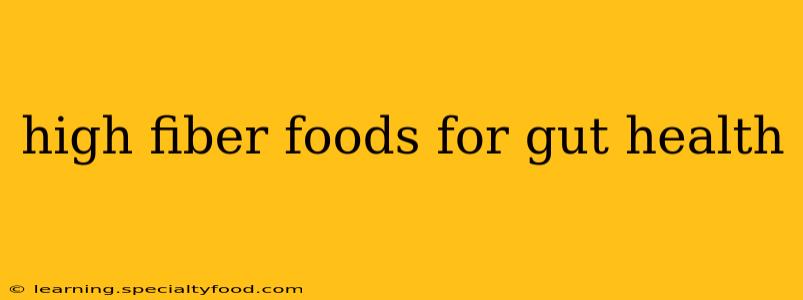Maintaining a healthy gut is crucial for overall well-being. A significant contributor to gut health is dietary fiber, which acts as prebiotic fuel for the beneficial bacteria residing in your intestines. This comprehensive guide explores high-fiber foods that can significantly improve your gut microbiome and overall digestive health. We’ll delve into the benefits of fiber, explore various high-fiber food categories, and answer frequently asked questions to provide you with a complete understanding of how to incorporate more fiber into your diet.
What are the Benefits of High-Fiber Foods for Gut Health?
Fiber, a type of carbohydrate the human body can't digest, plays a vital role in gut health. It acts as a prebiotic, feeding the beneficial bacteria in your gut, fostering a thriving microbiome. This, in turn, leads to several benefits:
-
Improved Digestion: Fiber adds bulk to your stool, making it easier to pass and preventing constipation. This reduces the risk of digestive issues like bloating, gas, and irregularity.
-
Enhanced Nutrient Absorption: A healthy gut microbiome is essential for efficient nutrient absorption. Fiber supports this process, ensuring your body gets the most from the foods you consume.
-
Strengthened Immune System: A significant portion of your immune system resides in your gut. A balanced microbiome, fostered by fiber, strengthens your immune response, making you less susceptible to illness.
-
Reduced Risk of Chronic Diseases: Studies link a healthy gut microbiome to a reduced risk of chronic diseases such as type 2 diabetes, heart disease, and certain cancers. Fiber plays a pivotal role in maintaining this healthy environment.
Types of Fiber: Soluble vs. Insoluble
Understanding the two main types of fiber – soluble and insoluble – is essential for maximizing their benefits.
-
Soluble Fiber: Dissolves in water, forming a gel-like substance. This helps regulate blood sugar levels and cholesterol. Good sources include oats, barley, apples, and beans.
-
Insoluble Fiber: Doesn't dissolve in water. It adds bulk to your stool, promoting regularity and preventing constipation. Good sources include wheat bran, whole grains, and many vegetables.
Ideally, your diet should include both soluble and insoluble fiber for optimal gut health.
High-Fiber Foods to Boost Your Gut Health
Here’s a breakdown of excellent high-fiber food sources to incorporate into your diet:
Fruits:
- Berries (Raspberries, Blueberries, Strawberries): Packed with antioxidants and fiber.
- Apples: Especially the skin, which contains significant amounts of insoluble fiber.
- Bananas: A good source of both soluble and insoluble fiber.
- Avocado: High in healthy fats and fiber.
Vegetables:
- Leafy Greens (Spinach, Kale, Collard Greens): Low in calories and high in fiber.
- Broccoli: A cruciferous vegetable rich in fiber and nutrients.
- Brussels Sprouts: Another cruciferous vegetable with high fiber content.
- Sweet Potatoes: Rich in fiber and beta-carotene.
Legumes:
- Beans (Kidney, Black, Pinto, etc.): Excellent sources of both soluble and insoluble fiber, as well as protein.
- Lentils: Another great source of fiber and protein.
- Peas: High in fiber and various vitamins and minerals.
Grains:
- Oats (Rolled or Steel-Cut): A fantastic source of soluble fiber, beneficial for heart health and blood sugar control.
- Whole Wheat Bread: Choose whole grain over refined bread for higher fiber content.
- Brown Rice: A healthier alternative to white rice, offering more fiber.
- Quinoa: A complete protein and a good source of fiber.
Nuts and Seeds:
- Almonds: Rich in fiber, healthy fats, and protein.
- Chia Seeds: Exceptionally high in fiber, particularly soluble fiber.
- Flax Seeds: Another excellent source of fiber, omega-3 fatty acids, and lignans.
How Much Fiber Should I Eat Daily?
The recommended daily intake of fiber varies depending on age and gender. Generally, adults should aim for 25-30 grams of fiber per day. However, gradually increasing your fiber intake is crucial to avoid digestive discomfort. Start by adding small amounts of high-fiber foods to your diet and gradually increase the quantity over time.
What Happens If I Eat Too Much Fiber?
While fiber is beneficial, consuming excessive amounts can lead to digestive issues like gas, bloating, and cramping. It's important to increase your fiber intake gradually and drink plenty of water to help your body adjust.
Are There Any Side Effects of Eating High-Fiber Foods?
Some people might experience digestive discomfort, such as gas and bloating, when they first increase their fiber intake. This is usually temporary and subsides as your gut adjusts. Drinking plenty of water helps to alleviate these side effects.
Can I Get Enough Fiber From Supplements?
While fiber supplements exist, they shouldn't replace whole foods. Whole foods provide a broader range of nutrients and benefits beyond just fiber. Supplements can be helpful in some cases, but they should be used under the guidance of a healthcare professional.
Conclusion
Incorporating high-fiber foods into your diet is a simple yet powerful step toward improving your gut health and overall well-being. By understanding the different types of fiber and selecting a variety of high-fiber foods, you can support a healthy microbiome, enhance digestion, and reduce your risk of chronic diseases. Remember to increase your fiber intake gradually and stay hydrated for optimal results. Remember to consult with your doctor or a registered dietitian for personalized advice tailored to your individual needs and health conditions.
